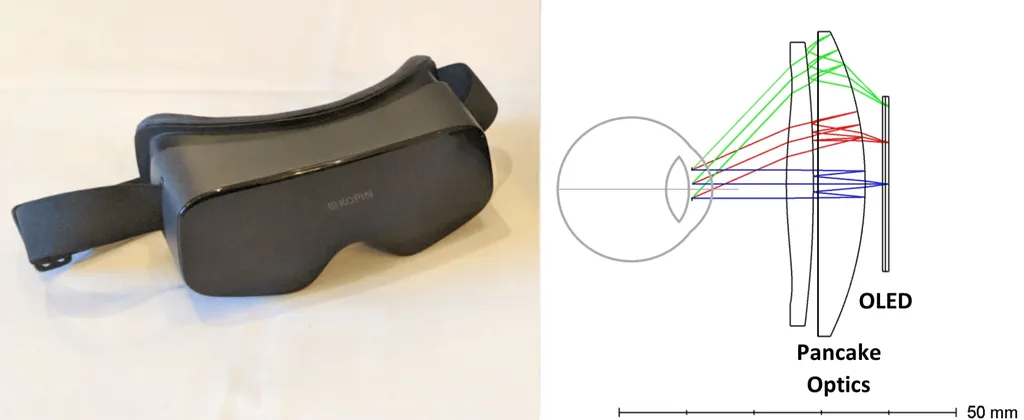Modern VR is a great deal more complex than it used to be. Lens, screen and tracking technology have all advanced greatly since the early days. Here's what I found that could help move this project forward on these key technology issues.
Lens
I forsee the development of the optics for this system to likely be the most difficult part of this project. However, I think I have a good starting point.
I think the right choice of lens type is pancake, due to their excellent size properties. However pancake lenses suffer greatly from issues of chromatic aberration due to their use of internal reflections to compensate for their short focal length. This will likely be worsened by the fact that I'm going to have to use plastic lenses, due to the extreme difficulty of working with glass. Traditionally, pancake lenses are made of glass, however Kopin has recently developed an all plastic pancake lens.

But how can I possibly produce cutting edge plastic lenses at home? FormLabs has shown the way. Engineers at FormLabs have successfully used their line of Clear Resin and resin 3D printers to create optical grade lenses for use in a fully 3d printed camera. Through the use of their method, I can rapidly prototype pancake lens designs to find the perfect one. Even better, this can be done at home by anyone with a resin printer and a dream. Additionally I can use free software such as OpticalRayTracer and 3DOptix to simulate my designs to save even more time in the prototyping process.
Screen
Modern VR screens are typically extremely small OLED microdisplays. Technology this cutting edge is normally not available to consumers outside of finished products, and while harvesting displays out of dead high end VR headsets is a potential option, it's one I'd rather avoid due to potential reproducibility issues for people following in the footsteps of this project. I think I've found a few interesting possibilities. In particular the night vision googles space seems to have a similar need for these displays, though at lower resolutions and manufacturers seem to be more willing to sell in smaller quantities and at more reasonable prices for these use-cases. Given OLED's naturally fast switching rate, I think it's possible that if I could get around the boards they come with, I could push the displays much harder to get 120 or even 144 hz out of them. Camera viewfinders are also a possible option here, but I've struggled to find one that even approaches an acceptable resolution.
Here's some of what I found for MicroOLED:
- https://www.amazon.com/Micro-OLED-1920X1080-Resolution-displays-Controller/dp/B0CG4HGFVF
- Amazon is as of-the-shelf as it gets. While you may balk at the initial $600 asking price, you'll find that it's not as unreasonable as it might first seem with this solution being mostly plug and play. Getting two displays in one purchase is quite nice. However I would probably want to get around that HDMI board to see if I can run the displays at a higher resolution, since as OLED's, they should theoretically be capable.
- https://www.displaymodule.com/products/1-03-inch-micro-oled-display-2560x2560-with-mipi?variant=47270617415873
- I think this display and the one below are actually from the same manufacturer, given how similar so much of it is. However, this one is a bit cheaper, from a seller I'm less familiar with.
- https://www.tindie.com/products/oled-modules/103-inch-2k-micro-oled-display-2560x2560-1800nits/
- While this display is more expensive, than the previous one, I think that may be because it's on a more reputable storefront. I decided to link it because I know how you guys are big fans of Tindie.
Going forward I would like to find out who the manufacturer of these displays is, as I hope to source directly from them to cut some of the final cost.
Additionally, there is the option of using more traditional large screen displays, though I will leave research on this to another time.
Tracking
Inside out XR tracking is a difficult nut to crack, especially in the open source world, as you want to limit the amount of cameras taking high quality pictures of your home to a minimum, and have to rely on a lot of older and/or highly inefficient AI models. Additionally the hardware is pretty rough, as there's very little good open source hardware out there to build off of for Inside out tracking. However this is a challenge I want to take on with this project, though it will have to wait for now as I try to get this thing off the ground first.
That's all I have for this update. Please message me with any suggestions or ideas you have for ways I can further this, every idea helps. Thanks!